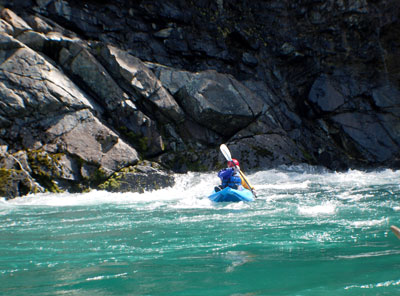|
Inflate or not? Just make sure your boat fits the rapids
 |
Zach Urness/Daily Courier
The Smith River in an IK. |
Inflatable kayaks have become an increasingly popular option for those looking to run serious whitewater. Here’s a look at what makes inflatables different from their hard-shell cousins, along typical price and options for IK boaters. o o o oBy Zach Urness of the Daily CourierTo inflate or not to inflate.That, at least for kayakers, is the question.For a long time conventional wisdom dictated that serious, technical whitewater was the sole providence of hard-shell boats, no questions asked.And while that’s still the case to some extent, there’s a growing number of people that choose to shoot more technical whitewater in inflatable kayaks or IKs.The number of IKs on Class IV runs has increased due in part to improving technology, with companies such as Merlin-based SOTAR continually designing boats that can handle tougher water.“What has definitely increased over the past 20 years is the use of IKs by more serious river runners who have a long-term commitment to the sport,” said Bill Cross, an Ashland resident who’s been boating for 34 years. “In the old days IKs were pretty much dismissed by these more skilled boaters, but today IK designs and materials have advanced to the point that people are running serious technical whitewater in them. Years ago that simply didn't happen.”The reasons for using an IK compared to a hard-shell are obvious. There’s more freedom of movement with the open top and you can transport them more easily in small cars.There’s also a sense that people with less experience are safer in IKs. Meaning, if you get into trouble in an IK you can just bail out — rather than rolling underwater or doing a wet exit in a hard shell.“I think an inexperienced person is safer in an IK,” said Nando Raynolds, a boater that lives in Talent. “I have always been nervous about being upside down and hitting my nose on a rock.”The ease of paddling is one reason local outfitter Orange Torpedo Trips have been running IKs on the Rogue River since the 1960s.“There are significant advantages to both IKs and hard kayaks, and drawbacks to both,” said Erik Weiseth, general manager of Orange Torpedo Trips. “I love inflatable kayaks for the beginner friendly nature of them. I can easily take a beginner and get them down a Class III or even Class IV river their first or second time in the boat.”One of the top level IKs on the market comes from SOTAR. The SL Liquid Kayaks are tough, well designed and maneuverable enough to navigate more technical rapids such as the Golf Course (IV) on the North Fork Smith or the Green Wall (IV/V) on the Illinois.The lightning fast self-bailing system and leg straps allow you to plow through big waves and drop off ledges without the boat getting swamped.Of course, you’re certainly going to pay for all those great features — not unlike a luxury car. The SOTAR kayaks typically retail for around $2,000.Another good IK that costs less is the AIRE Tributary Tomcat, which also allows for whitewater paddling but retails closer to $600 to $1,000.Not all IKs are safe for tougher whitewater, though. One of the most common problems is what I’ll call the “siren song of the cheap IK.”Years ago, I bought an IK for about $250 at Black Bird Shopping Center in Medford. The kayak wasn’t really designed for big water, but I took it there anyway and occasionally got myself into trouble when the boat swamped and sent me swimming. That’s not safe by any stretch of the imagination, especially in bigger water.“I have been overwhelmed in big water and in complex rapids in ways that I would not had I been in a hard shell,” Raynolds said.So, to inflate or not to inflate?The question isn’t a simple one, but the general rule is to do your research, and make sure the boat fits the rapids you intend to run.
| |
|





